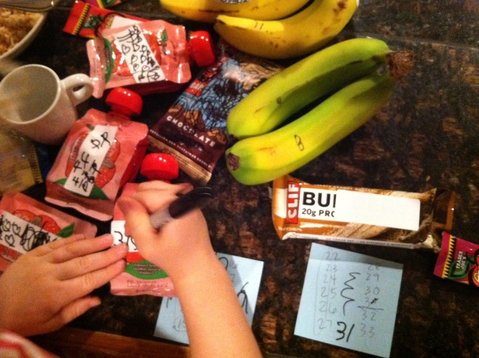 Common Core Standards Understand the relationship between numbers and quantities; connect counting to cardinality. LESSON PLAN: CONNECT COUNTING TO CARDINALITY Food is an exciting educational tool, and the best place to find food is the grocery store! Ask your student to make a list of snacks he/she would like to have. The list can be squiggles or drawings, with or without meanings. Planning is a great real-life habit! Good habits: Making shopping lists! Now, take a field trip to the grocery store. Drawing numbers on snacks. MATERIALS
A SNACK A DAY, A NUMBER A DAY! This lesson works best if it's done on the first day of the month! Go to the grocery store. Grab a cart for yourself and a cart for your student. Explain that the student gets to pick out 30 (or 31) snacks. One for each day of the month. Shop alongside your student, and try not to interfere. Depending on your student's snack habits, feel free to establish parameters on what is allowed (or not) into the cart. Try to establish parameters before the shopping begins (price, sugar content, allergens, etc.). If you're watching the budget, you may want to review your student's items before checking out. Let your student go through the line alone, if they're up for it, and the grocery store staff is positive. Discuss the purchases on the way home, as well as the next step of the lesson: when you get home, all the snack items will be counted, and numbered according to which day the item will be eaten. You may want to ask questions like, "Which item do you want to eat the most? Which one are you most excited about?" Unload the groceries and start counting! Allow your student to go about the process orderly or haphazardly. Items can be lined up, or randomly grabbed and numbered. Have a calendar available for referencing. When your student has a question about how to write a number, show the number on the calendar. Show on the calendar how each day will have a snack and the number on the snack will match the number on the calendar. Your student may have a tendency to number all of the yogurts first, and all the granola bars second. That's ok! When your student gets bored with yogurt on Day 5, there will be a great learning opportunity! Encourage your student to make connections between the snacks and the days of the month, and the reality of eating granola bars all week. Allow your student to re-number the snacks or trade the labels, if this idea occurs to the student. Perfection in writing numbers is not imperative. Focus on the concept and take note of which numbers need help. By focusing on big-picture concepts rather than details, students will feel the joy of knowing more, and the resulting confidence will aid in faster mastery of the details. Prepare to review this lesson each day for the next month! Put the snacks in a box, locked cupboard, shelf on the refrigerator--and keep your student out of the lesson snacks! If the student breaks into the snack stash, use this to dive into a bigger, real-life lesson. REAL LIFE LESSONS: PLANNING AHEAD TALKING POINTS
MENTOR CHECK-UP If your student has a business mentor, encourage your student to share the progress of this lesson. Suggest that the student invite the mentor over for snacks! Allow your student to do the math on sharing one of the 30 snacks! Is there a creative solution, a win-win? Let your student explain the Snack Counting Lesson to the mentor. Ask the mentor to share any stories of planning (adjusting, failing, succeeding, persevering). If possible, visit the mentor's business to see how important Planning Ahead is to a business! |
Win Room School
Win Room School House boosts confidence by inspiring students to set and achieve goals, setting their own accelerated pace for life-long learning. WIN!
All Founder Monticello Academy San Antonio Summer Program Team |

 RSS Feed
RSS Feed